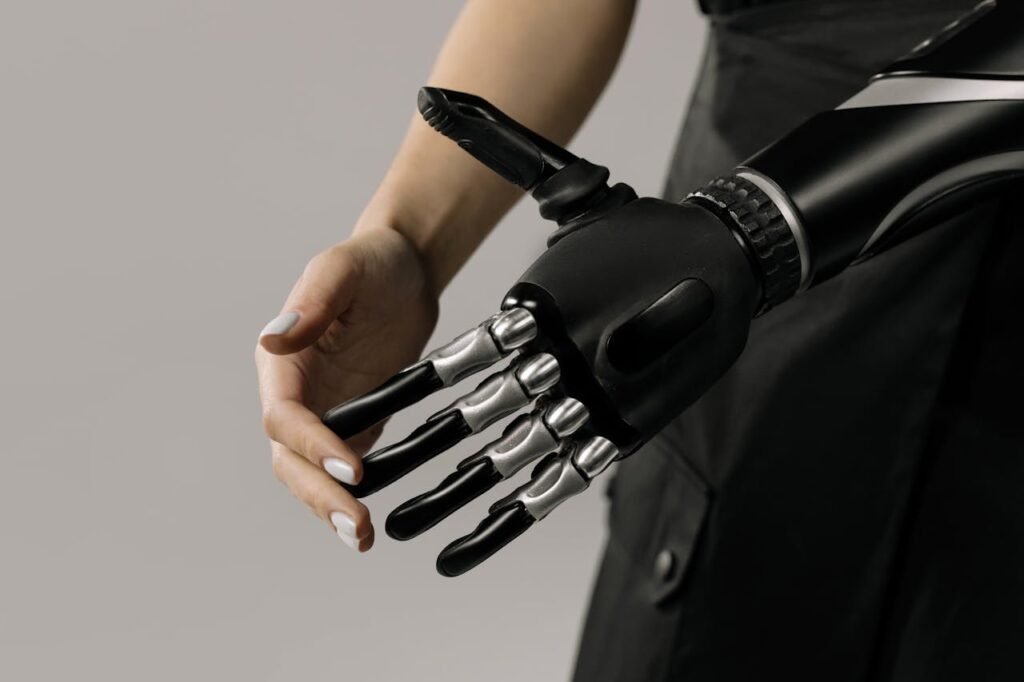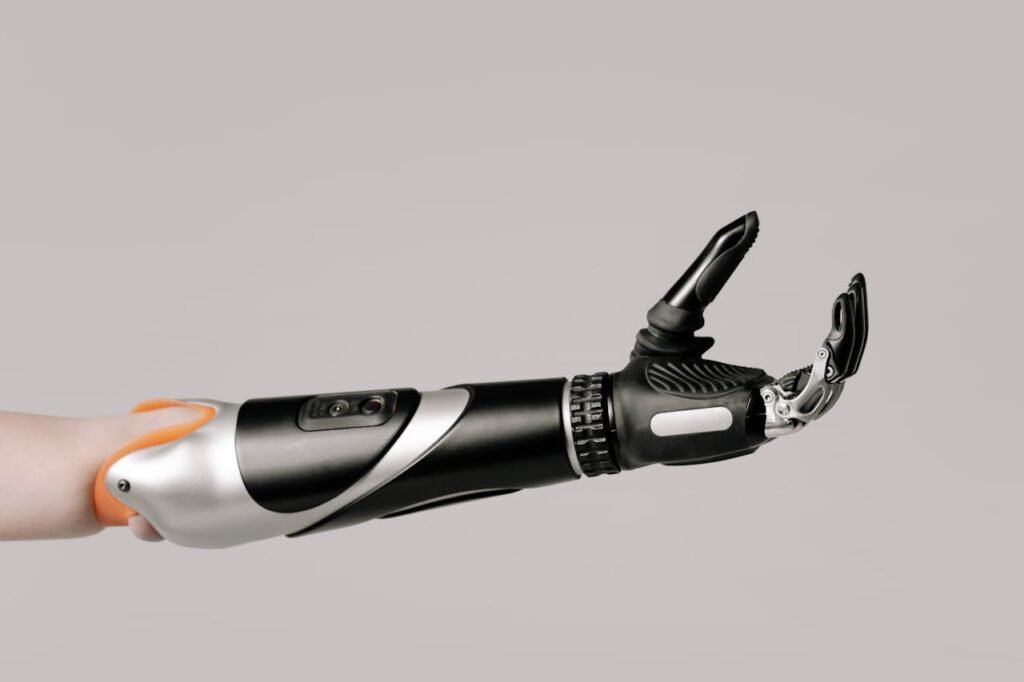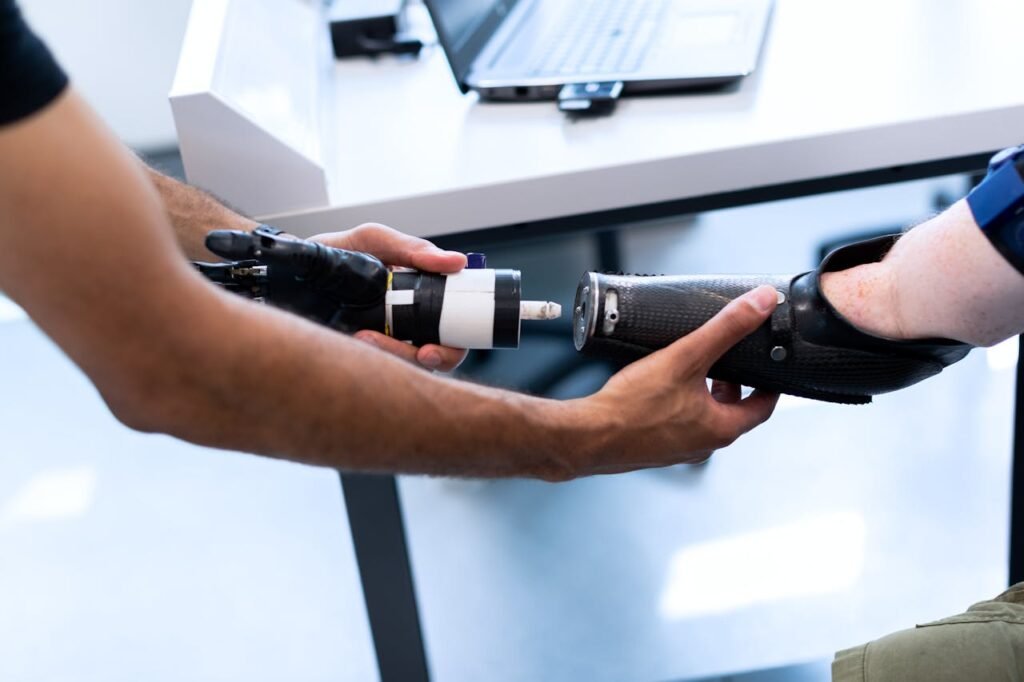When someone loses a limb, the journey doesn’t stop with surgery. The real work begins after that—healing, strengthening, and slowly learning to move again. That’s where EMS, or Electronic Muscle Stimulation, becomes an important tool.
If you’re an amputee or caring for one, you’ve probably heard of EMS. Maybe you’ve even used it a few times. It helps the muscles stay active. It reduces pain. And it makes the body ready for a prosthetic.
But one common question keeps coming up: Can you use EMS every day?
This article answers that question, and many more around it. We’ll walk you through the benefits of EMS, the risks of overuse, and how daily EMS might affect your recovery. We’ll keep it easy to understand, and more importantly—practical.
Let’s get into it.
Understanding EMS and Its Role in Amputee Recovery
What EMS Actually Does

EMS, or Electronic Muscle Stimulation, sends gentle electrical pulses to your muscles. These pulses make the muscles contract and relax, just like they would if you were moving them on your own.
For amputees, this is especially useful. After surgery, the remaining part of the limb often doesn’t move much. Muscles become weak. EMS helps keep them active, even when natural movement is hard.
It’s like giving your muscles a workout, without needing to lift weights or do hard exercises.
Why It’s Important After Amputation
When a limb is removed, the muscles around it don’t just stop working—they also start shrinking if not used. This makes it harder to wear and control a prosthetic.
EMS keeps those muscles alive. It helps improve circulation, reduces stiffness, and even calms nerve pain.
This is why many doctors and physiotherapists include EMS as part of the recovery process. It’s not just optional—it’s helpful and often necessary.
EMS and Phantom Pain
One of the hidden struggles of being an amputee is phantom pain. That’s when you feel pain in the part of your body that’s no longer there.
EMS can help reduce that. By stimulating the nerves and muscles around the amputated area, EMS interrupts the pain signals going to your brain.
This doesn’t work for everyone the same way. But for many, regular EMS makes the pain easier to live with.
Can EMS Be Used Every Day?
The Short Answer
Yes, in many cases, EMS can be used daily—but with care. Daily sessions are not only safe for most amputees, but also beneficial when done right.
Still, there are limits. Just like exercise, too much EMS without rest can lead to fatigue or soreness. The key is to listen to your body and follow a balanced plan.
When Daily EMS Works Best
Daily EMS is most effective during the early stages of rehab. After surgery, when muscles are weak and you’re not using your limb much, EMS becomes the main source of stimulation.
During this phase, daily short sessions can make a big difference. They prevent muscle wasting and support the body as it gets used to new movement.
As your strength builds, EMS remains useful, but how often you use it may change.
Ideal Session Length
Most therapists recommend keeping EMS sessions between 15 to 30 minutes at a time. You can do this once or twice a day, depending on your condition and energy level.
Going beyond that won’t make your muscles grow faster—it might just make them sore or tired.
And like any tool, it’s not about how long you use it, but how consistently and correctly you do it.
How to Safely Use EMS Every Day as an Amputee
Start With a Clear Plan

Before you begin daily EMS, talk to your physiotherapist or doctor. Every amputee’s journey is different. Some may have had a clean surgery with a fast recovery. Others may still be healing from wounds or managing pain.
A professional can help you decide where to place the electrodes, how much intensity to use, and how long each session should be. They’ll also help you adjust the settings if your condition changes.
Never start EMS on your own without some form of expert guidance, especially if your stump is still healing or swollen.
Understand the Right Timing
For most amputees, EMS is most useful in the first few months after surgery. This is when muscles are at their weakest, and regular movement is still limited.
Daily use during this time can protect your muscle tone, maintain joint flexibility, and prevent the skin around the stump from stiffening.
Once you’ve fitted a prosthetic and started walking or doing regular movement again, you might not need daily EMS anymore. But that doesn’t mean you stop completely. You may shift to every other day or a few times a week for maintenance.
This flexible use keeps your muscles healthy without overworking them.
Watch for Signs of Overuse
Just like with exercise, using EMS too much can backfire. You might notice soreness, unusual fatigue, or even slight swelling around the pad areas. If this happens, reduce the frequency or intensity.
The goal of EMS is support, not strain. You’re not trying to build muscle like a bodybuilder—you’re trying to maintain function, reduce pain, and improve comfort with your prosthetic.
If your skin feels irritated, take a break and apply soothing lotion after cleaning the area. Make sure your pads are clean, and you’re not using the same exact spot every day.
Changing pad positions slightly each day can help avoid skin stress.
Combine EMS With Movement
The best results come when EMS is part of a larger routine. If possible, follow your EMS session with simple exercises—like light stretching, walking practice, or using your prosthetic for basic movements.
Even five minutes of walking or balance training after EMS can improve your coordination and speed up recovery.
This combination helps your brain and muscles work together. It also prepares you for more complex movement later.
If you’re not yet ready to move much, that’s okay. Just doing EMS consistently is still better than doing nothing.
Benefits of Consistent Daily EMS Use
Muscle Preservation
Muscle loss after amputation happens quickly. Within just a few weeks of inactivity, muscles can start shrinking. This makes fitting a prosthetic harder and less comfortable.
Daily EMS sessions keep those muscles active. They contract the muscle fibers, even if you’re not doing physical movement. This slows down the shrinking process and keeps the area firm and toned.
That makes your recovery easier and improves the fit of your prosthetic when the time comes.
Better Nerve Communication
The brain and the muscles need to stay connected—even after amputation. EMS helps keep those pathways open.
When your brain sends a signal to move, and your EMS machine helps activate the muscle at the same time, your brain starts to “remember” that movement.
Over time, this helps reduce phantom sensations, improves response time, and creates smoother control when you begin using a bionic hand or mechanical leg.
This brain-muscle memory is important for long-term function.
Pain Management
Daily EMS can also help manage pain. Gentle stimulation improves blood flow, which reduces swelling and muscle tension.
It also disrupts the pain signals traveling to your brain, especially if you’re dealing with phantom limb sensations or stump pain.
Instead of taking painkillers every day, many amputees find that daily EMS reduces the need for medication and helps them sleep better at night.
Choosing the Right EMS Device for Daily Use
Not All EMS Machines Are Made Equal

When you’re planning to use EMS every day, the quality of the machine matters more than you think. Many devices sold online or in gyms are made for short-term use or for cosmetic muscle toning—not medical rehab.
For amputees, daily use means you need a machine that is safe, reliable, and designed for long-term therapy.
The machine should allow you to control the intensity. It should offer multiple modes, so you can switch between muscle strengthening and pain relief. It should also come with skin-friendly pads and clear safety features.
Choosing the wrong device can lead to poor results—or even injury. That’s why it’s important to get a machine that is backed by clinical guidance.
Why Robobionics Recommends BrawnBand
At Robobionics, we built BrawnBand to be safe for everyday use. It’s simple, portable, and made specifically for amputees and rehab patients in India.
With adjustable settings and medical-grade current levels, it gives you full control without overwhelming your muscles. You can use it in the morning, at night, or even while sitting at your desk.
Because it was made in India, BrawnBand is also designed to handle Indian conditions—heat, humidity, and long-term home use. The support team is available in multiple languages and is always ready to help.
Whether you live in a metro city or a small town, you can trust BrawnBand for safe daily rehab.
What to Avoid in a Daily Use EMS Device
Stay away from devices that don’t list their intensity levels or come without guidance. If the user manual is hard to understand or there’s no clear customer support, it’s not a good fit.
Also be careful of machines that offer “extreme” stimulation modes. More power isn’t better. In fact, too much intensity can make your muscles tired, cause soreness, or even damage your skin.
Go for a device that offers gentle, controlled pulses with enough flexibility to grow with your rehab progress.
Building a Sustainable EMS Routine
Set a Regular Time
Just like brushing your teeth, EMS works best when it becomes part of your day. Choose a time that’s quiet and stress-free—morning before breakfast, or evening after dinner.
This habit helps you stay consistent, which is far more important than the number of minutes you use it.
You don’t need to block an hour for EMS. A focused 15–20 minutes can do wonders if done every day with care.
Keep a Rehab Log
Write down your session each day. Note the time, intensity level, how you felt before and after, and any progress you notice.
This helps you stay motivated, and it also helps your therapist adjust your plan over time.
Even if you miss a session or two, don’t give up. Use your log to bounce back and stay on track.
Involve Your Family
Having a caregiver or loved one help with your EMS setup can make it easier and safer—especially in the early days.
They can remind you, assist with pad placement, or just sit with you during the session. This shared time can be comforting and keeps your rehab journey from feeling like a burden.
Over time, many users become fully independent with their EMS routine—but it’s okay to ask for help in the beginning.
When You Should Not Use EMS Daily
Healing Wounds or Infections
If your surgical site hasn’t fully healed, or you have an open wound near your stump, avoid using EMS near that area. The electrical pulses can irritate the skin or delay the healing process.
Always wait until your doctor or physiotherapist confirms it’s safe to begin stimulation around the surgical site. If there’s any redness, discharge, or unusual warmth around the area, pause your sessions and get it checked.
Daily EMS is helpful—but only when your body is ready for it.
Experiencing Unusual Discomfort
If you feel sharp pain, sudden cramping, or a strong burning sensation during your EMS session, stop immediately. These aren’t normal effects.
This could mean your settings are too high, your pads are placed incorrectly, or your body simply needs a rest day. It’s okay to skip a session when something doesn’t feel right.
It’s better to pause and consult your therapist than to push through and cause harm.
Fatigue and Muscle Exhaustion
Just like exercise, EMS uses up energy. If your muscles feel unusually sore or tired the next day, that’s a sign you might be doing too much too soon.
In these cases, reduce the frequency to every other day, or lower the intensity. Then slowly work your way back up.
Recovery is not a race. Progress is progress, even if it takes longer.
Long-Term Daily EMS Use: What to Expect
The First Few Weeks

In the beginning, EMS may feel strange. You might feel your muscles jump or contract in a way they haven’t in a long time. That’s normal.
You may also feel a slight tingling during or after the session. Over time, your body adjusts. The sensations become more familiar, and the benefits become more noticeable.
You may start seeing early improvements in muscle tone, reduced pain, or better stump control after two to three weeks of regular use.
After One Month
By the end of the first month, many users report stronger movement in the limb, reduced muscle tightness, and easier transition into physical activity.
If you’re preparing for a prosthetic fitting, EMS use during this stage can improve the comfort and stability of the fit. Your muscles will be more responsive, and your body will feel more balanced.
This is a key phase, where combining EMS with guided movement can bring the best results.
Ongoing Use Beyond Three Months
For some amputees, EMS becomes a long-term habit. It helps manage chronic pain, supports ongoing muscle health, and fits into a larger daily wellness routine.
At this stage, you may reduce the frequency to 3–4 times a week, or use it in cycles. Some users take short breaks and return to EMS when they feel tightness or discomfort returning.
There’s no fixed rule here. Your therapist can help you decide what’s best for your body and your lifestyle.
The important thing is to listen to how your muscles respond—and use EMS as a tool, not a crutch.
How Clinics and Rehab Providers Can Leverage Daily EMS Use for Business Growth
Move From Sessions to Solutions

One of the biggest challenges for physiotherapy and rehab businesses is patient drop-off. Many patients don’t complete their rehab plan. They get tired. They can’t travel every day. They stop seeing progress and lose motivation.
Daily EMS offers a way to change this.
Instead of selling therapy sessions, clinics can begin offering complete solutions. A solution includes EMS therapy at the clinic, plus support for at-home use. This gives the patient a full-circle experience—from guided learning to independent use.
You’re no longer just providing care during a visit. You’re now part of their daily recovery, even when they’re not in front of you.
This increases patient engagement, satisfaction, and trust. And trust leads to referrals, long-term relationships, and better word-of-mouth marketing.
Add Subscription and Rental Models
Daily EMS use opens up new pricing models beyond per-session billing.
Clinics can offer EMS rental packages—where a patient rents a device for home use, while still checking in weekly or biweekly with the therapist. This creates a recurring revenue stream with very little overhead.
Some clinics go a step further and offer monthly rehab subscriptions. These include:
- One or two in-clinic sessions
- A take-home EMS device
- Progress tracking
- Therapist calls or WhatsApp check-ins
This model works especially well in Tier-2 cities, where people want quality care but cannot travel daily. It’s convenient for patients and profitable for providers.
Bundle EMS With Prosthetic Training
For prosthetic centers, adding EMS is a smart way to improve outcomes and reduce fitting failures.
Instead of waiting for the prosthetic fitting to start training, you can begin EMS therapy during the early recovery stage. Daily EMS helps strengthen the stump, reduce phantom pain, and prepare the residual limb for better socket fit and control.
Patients who start EMS early often adapt to their prosthetics faster and with fewer adjustments.
This reduces the total fitting timeline, improves customer satisfaction, and gives your clinic a competitive edge.
You can offer packages like:
- “Pre-Fit Muscle Activation Plan”
- “Post-Fit Adjustment Support”
- “Prosthetic Readiness Booster”
Each bundle can include EMS sessions, prosthetic training, and home-use guidance. It adds value and positions your clinic as a full-service recovery partner—not just a device provider.
Position Daily EMS Use as a Premium Offering
Most people still don’t know the power of EMS when used consistently. That’s an opportunity.
Instead of offering EMS as just a short add-on, frame it as a premium offering that delivers real recovery benefits. Build education around it—through blogs, workshops, demo days, and printed guides.
When patients understand why daily EMS matters, they’re more likely to commit. They also see your clinic as advanced and trustworthy.
Use real patient stories (with permission) to show the difference between irregular rehab and structured, daily EMS care.
Even in cost-sensitive markets, patients will pay more for results they can feel.
Train Your Staff to Lead With Care
For daily EMS use to succeed as a business tool, your team needs to be confident in it.
Train your physiotherapists, rehab aides, and front-desk staff on how to:
- Explain the benefits of EMS clearly
- Show patients how to use the machine safely
- Offer tips on integrating EMS into daily life
- Track results and make simple adjustments
When your whole team is aligned, EMS becomes more than a tool. It becomes part of your clinic’s identity.
You’re no longer just helping people heal—you’re empowering them to take control of their recovery.
Build Loyalty Through Long-Term Progress
Most patients don’t expect miracles. But they do want to feel seen, supported, and guided.
When you help them build a daily EMS habit—with your clinic in the loop—you become a long-term partner, not just a service provider.
They come back for check-ins. They recommend you to others. They trust you with their health journey.
And in a business where trust is everything, that’s how you grow.
How Robobionics Supports Safe and Consistent EMS Use
Built for Daily Rehab, Not Just Occasional Use

At Robobionics, we knew that amputees needed more than just another EMS machine. They needed a device that could be trusted for daily use. That’s why we created BrawnBand.
It’s not a cosmetic gadget or a one-time-use tool. BrawnBand was made for long-term rehab. The materials are durable, the settings are medically sound, and the performance is stable—even with daily use.
Our engineers worked with physiotherapists and amputees to make sure the stimulation levels stay within safe limits, even if you use it every day.
We’ve seen users keep up their EMS routine for months—and get results without worry.
Support That Doesn’t Stop After You Buy
We don’t just sell you a machine and disappear. When you choose BrawnBand, you get full support—by phone, video call, or even in-person through our clinic partners.
Our rehab team helps you set up your routine, fix your pad placement, and check your intensity level. If anything feels off, we’re right there to guide you.
We also offer refresher sessions, printed guides in local languages, and weekly tips to keep you motivated.
We know rehab can feel lonely, especially if you’re doing it at home. That’s why we stay connected with our users long after the first demo.
Real Feedback From Real Users
Many of our users were unsure at first. They asked the same question: Can I really use this every day?
And now, weeks and months later, they’re the ones telling others, You should try this—it changed my recovery.
People tell us their prosthetic fits better. That they feel stronger. That they’ve finally found a way to manage phantom pain without pills. That they look forward to their EMS time, because it’s their quiet moment of progress.
These aren’t just reviews. They’re real-life examples of how daily EMS—when done right—can change everything.
Final Words: Consistency Is Strength
So, can amputees use EMS every day? Yes. And for many, they absolutely should.
But it’s not just about frequency. It’s about being smart. Being gentle. Being consistent.
It’s about knowing when to push, and when to rest. It’s about choosing the right device, the right guidance, and the right routine that fits into your life—not the other way around.
At Robobionics, we believe in strength that grows one pulse at a time. We believe in recovery that begins at home. And we believe in tools that adapt to your journey—not just your diagnosis.
If you’re ready to take that next step, we’re here for you.
Book a free demo of BrawnBand at https://www.robobionics.in/bookdemo
Let’s make daily rehab feel possible, personal, and powerful—together.


